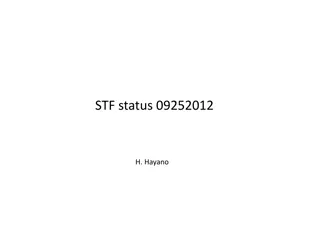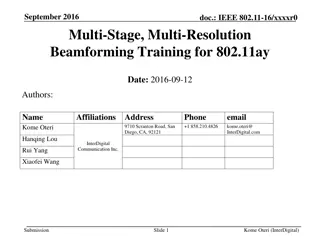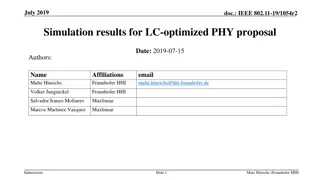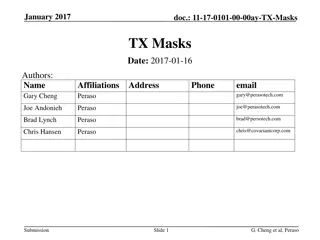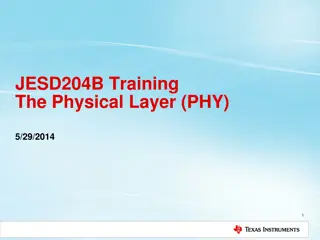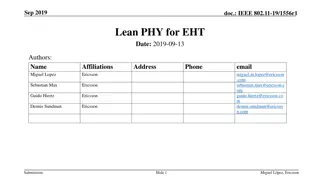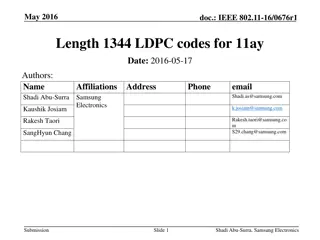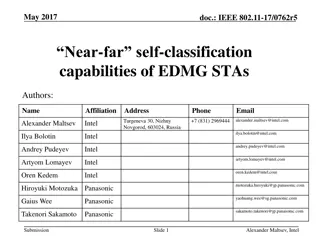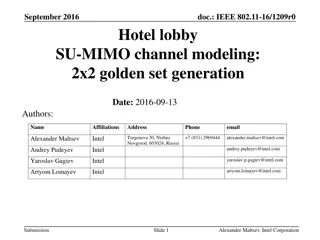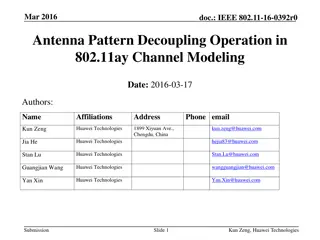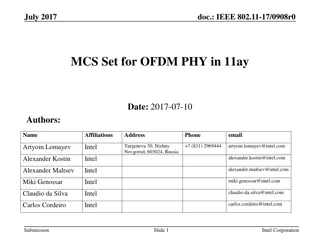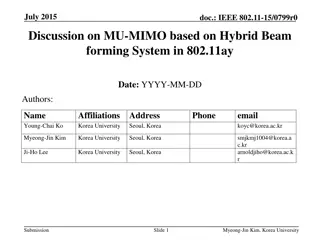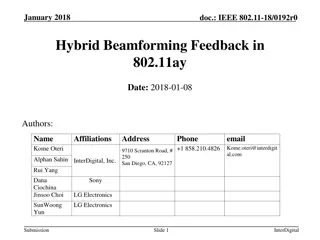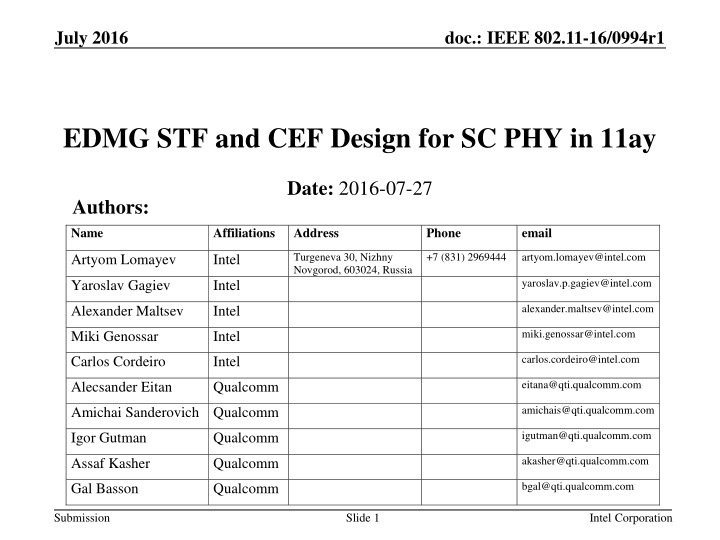
IEEE 802.11-16/0994r1 EDMG-STF and CEF Design for SC PHY in 11ay
This presentation discusses the design of EDMG-STF and CEF fields for the preamble portion in IEEE 802.11ay standard, focusing on utilizing Golay complementary sequences and defining these fields for different transmission scenarios. It also compares the proposed EDMG-STF with the legacy DMG-STF in 11ad, highlighting their structures and purposes.
Download Presentation

Please find below an Image/Link to download the presentation.
The content on the website is provided AS IS for your information and personal use only. It may not be sold, licensed, or shared on other websites without obtaining consent from the author. If you encounter any issues during the download, it is possible that the publisher has removed the file from their server.
You are allowed to download the files provided on this website for personal or commercial use, subject to the condition that they are used lawfully. All files are the property of their respective owners.
The content on the website is provided AS IS for your information and personal use only. It may not be sold, licensed, or shared on other websites without obtaining consent from the author.
E N D
Presentation Transcript
July 2016 doc.: IEEE 802.11-16/0994r1 EDMG STF and CEF Design for SC PHY in 11ay Date: 2016-07-27 Authors: Name Affiliations Address Phone email +7 (831) 2969444 Turgeneva 30, Nizhny Novgorod, 603024, Russia artyom.lomayev@intel.com Artyom Lomayev Intel yaroslav.p.gagiev@intel.com Yaroslav Gagiev Intel alexander.maltsev@intel.com Alexander Maltsev Intel miki.genossar@intel.com Miki Genossar Intel carlos.cordeiro@intel.com Carlos Cordeiro Intel eitana@qti.qualcomm.com Alecsander Eitan Qualcomm amichais@qti.qualcomm.com Amichai Sanderovich Qualcomm igutman@qti.qualcomm.com Igor Gutman Qualcomm akasher@qti.qualcomm.com Assaf Kasher Qualcomm bgal@qti.qualcomm.com Gal Basson Qualcomm Submission Slide 1 Intel Corporation
July 2016 doc.: IEEE 802.11-16/0994r1 Introduction This presentation proposes EDMG-STF and CEF fields design of EDMG portion of preamble for SC PHY defined in the SFD, [1]. First, the general structure of the EDMG-STF and CEF fields utilizing the Golay complementary sequences is proposed and then exact definition of the Golay sequences is provided. The EDMG-STF and CEF fields are defined for SISO and MIMO transmission and channel bonding of 2 and 4 channels. Submission Slide 2 Intel Corporation
July 2016 doc.: IEEE 802.11-16/0994r1 EDMG-STF & CEF Structure Submission Slide 3 Intel Corporation
July 2016 doc.: IEEE 802.11-16/0994r1 Legacy DMG-STF in 11ad The legacy DMG-STF is defined using Ga128 Golay sequence of length 128 chips and consists of 16 repetitions of Ga128 and the sequence with inverse sign -Ga128 at the end, [2]. The DMG-STF field is used for: Frame detection; Initial acquisition and sync; AGC setup; Carrier frequency offset estimation; Other possible estimations, including noise power measurement, etc.; Ga128 Ga128 . . . Ga128 -Ga128 2176 * Tc Submission Slide 4 Intel Corporation
July 2016 doc.: IEEE 802.11-16/0994r1 Proposed EDMG-STF in 11ay The EDMG-STF field is present in the frame transmitted over the number of contiguous 2.16 GHz channels and/or several spatial streams in MIMO case. The proposed EDMG-STF field also uses Ga Golay sequence in their definition, however introduces additional lengths of 256 and 512 for the CB = 2 and 4 accordingly. The primary purpose of the EDMG-STF: AGC setup; Possibly a refinement of the sync operating at the higher sampling rate; Submission Slide 5 Intel Corporation
July 2016 doc.: IEEE 802.11-16/0994r1 Proposed EDMG-STF Structure (Cont d) BW The EDMG-STF field for spatial stream i is built of the multiple repetitions of the Gwi sequence defined as follows: Gwi = [GaiN, GaiN, GaiN, -GaiN]; The number of Gwi sequences in the EDMG-STF field is TBD; GaiN is a Golay sequence of length N; N is a sequence length, equal to 128, 256, and 512 for the CB = 1, 2, and 4 accordingly; NOTE: regardless of the CB type (or BW) the EDMG-STF has the same time duration; Chip duration: Tc = 0.57 ns; Gai Gai Gai -Gai 2.16 GHz 128 128 128 128 512 * Tc Gai Gai Gai -Gai 2.16 GHz * 2 256 256 256 256 1024 * (Tc/2) Gai Gai Gai -Gai 2.16 GHz * 4 512 512 512 512 Time 2048 * (Tc/4) Submission Slide 6 Intel Corporation
July 2016 doc.: IEEE 802.11-16/0994r1 Legacy DMG-CEF in 11ad The legacy DMG-CEF is defined using Golay pair of complementary sequences Ga128 and Gb128 of length 128 chips, [2]. The primary purpose of DMG-CEF field: Channel estimation in time and frequency domain; The CEF field is composed of Gu512 and Gv512 sequences: Gu512 = [-Gb128, -Ga128, +Gb128, -Ga128]; Gv512 = [-Gb128, +Ga128, -Gb128, -Ga128]; Appended with the -Gb128 sequence at the end. Gu512 Gv512 Gv128 -Gb128 -Ga128 +Gb128 -Ga128 -Gb128 +Ga128 -Gb128 -Ga128 -Gb128 Submission Slide 7 Intel Corporation
July 2016 doc.: IEEE 802.11-16/0994r1 CIR Estimation in Time Domain The Channel Impulse Response (CIR) estimation is based on the complementary property of the Ga and Gb sequences. The sum of autocorrelation function for GaN and GbN of length N is a delta Dirac function: ( ) ( ) Gb n Ga n Ga N N N + ( ) ( ) n ( ) n = n Gb N where symbol denotes circular convolution, -n index defines the inverse order of samples in the GaN/GbN sequence. Applying that property the CIR estimation h(n) can be simply realized as follows: ( ) ( ) ( ) ( ) n Gb n Ga n h n Ga N N N + ( ) n ( ) n ( ) n ( ) n ( ) n = = h Gb h h N Submission Slide 8 Intel Corporation
July 2016 doc.: IEEE 802.11-16/0994r1 Requirements for EDMG-CEF in 11ay The requirements: Reuses the legacy DMG-CEF structure based on the Golay sequences; Allows channel estimation in time and frequency domain; Provides channel estimation for channel bonding of several frequency channels; Supports MIMO channel estimation; The design should be extendable for an arbitrary number of spatial streams; Similar to the EDMG-STF field for the channel bonding of 2 and 4, the Golay sequences of length N = 256 and 512 are used accordingly. proposed EDMG-CEF design meets the following Submission Slide 9 Intel Corporation
July 2016 doc.: IEEE 802.11-16/0994r1 EDMG-CEF Design for 2 Streams The design of the CEF for 2x2 MIMO case is based on the Zero Cross Correlation (ZCC) property of the Golay sequences. It can be shown that 2 complementary pairs of Golay sequences (Ga1N, Gb1N) and (Ga2N, Gb2N) have ZCC if the following property is satisfied: ( ) ( ) ( ) ( ) ,... 4 , 2 , 0 , = = n n Gb n Gb N N Gb ( ) ( ) n ( ) ( ) n = = = 5 , 3 , 1 = 2 N 1 N 2 N 1 N , 4 , 2 , 0 ,... , ,... Ga n Ga n n Ga n Ga n n = 5 , 3 , 1 = 2 1 2 N 1 N , ,... Gb n The sequences have identical elements for even values of the index n and elements with inverse polarity for the odd values of index n. The ZCC property can be written as follows: ( ) ( ) n ( ) ( ) n ( ) ( ) n ( ) ( ) n + = + = 1 N 2 N 1 N 2 N 2 N 1 N 2 N 1 N 0 Ga n Ga Gb n Gb 0 Ga n Ga Gb n Gb Submission Slide 10 Intel Corporation
July 2016 doc.: IEEE 802.11-16/0994r1 EDMG-CEF Design for 2 Streams (Cont d) The EDMG-CEF design for 2x2 MIMO case is shown in figure below: Gu14N and Gv14N are composed of Ga1N/Gb1N Golay sequences; Gu24N and Gv24N are composed of Ga2N/Gb2N Golay sequences; CEFs for spatial streams #1 and #2 have the same structure as a legacy CEF; Gu1 Gv1 -Gb1 Stream #1 4N 4N N Gu2 Gv2 -Gb2 Stream #2 4N 4N N Submission Slide 11 Intel Corporation
July 2016 doc.: IEEE 802.11-16/0994r1 Channel Estimation for 2 Streams The channel estimation can be done in time and frequency domain. For the sake of algorithm explanation the channel estimation is considered in frequency domain. Let s introduce Ui4N and Vi4N vector definitions as a DFT of the corresponding time domain signals Gui4N and Gvi4N as follows (the length 4N is skipped for simplicity): ( V Gu DFT U = , The receive vectors at the first RX antenna in frequency domain can be defined as follows: Z U H U H Yu + + = Yv ) ( ) = i i i i DFT Gv = + + 1 1 2 1 1 1 2 2 H V H V Z 11 12 11 12 H11 and H12 are target channel coefficients to be estimated, Z1 and Z2 are additive noise vectors. Submission Slide 12 Intel Corporation
July 2016 doc.: IEEE 802.11-16/0994r1 Channel Estimation for 2 Streams (Cont d) Channel estimation for H11 coefficient can be found by application of matched filter solution to vectors U1 and V1 as follows: ( 11 11 V V U U H YvV YuU + = + = ) ( ) ^ + + + + 1 * 1 * 1 1 * 1 1 * 2 1 * 2 1 * 1 1 * 2 1 * H H U U V V Z U Z V 12 = = 1 0 Note that the inter-stream interference term is cancelled out due to the ZCC property of the sequences. Similar the channel estimation for H12 coefficient can be found as follows: ( 12 V V U U H YvV YuU + = + = ) ( ) ^ + + + + 2 * 2 * 2 2 * 2 2 * 1 2 * 1 2 * 1 2 * 2 2 * H H U U V V Z U Z V 12 11 = = 1 0 Here matched filtering is done for vectors U2 and V2. Submission Slide 13 Intel Corporation
July 2016 doc.: IEEE 802.11-16/0994r1 EDMG-CEF Design for 4 Streams The proposed method for the EDMG-CEF construction can be generalized for the high order MIMO. Let s consider an example of 4x4 MIMO. The original complementary Golay pairs (Ga1N, Gb1N) and (Ga2N, Gb2N) are supplemented with the two additional pairs (Ga3N, Gb3N) and (Ga4N, Gb4N). Note that (Ga3N, Gb3N) and (Ga4N, Gb4N) have ZCC similar to the pairs (Ga1N, Gb1N) and (Ga2N, Gb2N). Additionally, all Golay sequences utilized in the design are orthogonal to each other. Submission Slide 14 Intel Corporation
July 2016 doc.: IEEE 802.11-16/0994r1 EDMG-CEF Design for 4 Streams (Cont d) 4 streams are transmitted during 2 time intervals as shown below. Sequences for streams #3 and #4 have inverse sign for T2. Time interval T1 Time interval T2 Gu1 Gv1 -Gb1 Gu1 Gv1 -Gb1 Stream #1 4N 4N N 4N 4N N Gu2 Gv2 -Gb2 Gu2 Gv2 -Gb2 Stream #2 4N 4N N 4N 4N N Gu3 Gv3 -Gb3 -Gu3 -Gv3 +Gb3 Stream #3 4N 4N N 4N 4N N Gu4 Gv4 -Gb4 -Gu4 -Gv4 +Gb4 Stream #4 4N 4N N 4N 4N N Submission Slide 15 Intel Corporation
July 2016 doc.: IEEE 802.11-16/0994r1 Channel Estimation for 4 Streams Let s consider channel estimation for the first RX antenna in frequency domain. The received vectors in frequency domain during time intervals T1 and T2: = + + + + = + + 1 T 1 2 3 4 1 T 1 2 3 4 Yu H U H U H U H U Z Yu H U H U H U H U Z 1 11 12 13 14 , 1 2 11 12 13 14 , 2 u T u T = + + + + 1 T 1 2 3 4 Yv H V H V H V H V Z = + + 1 T 1 2 3 4 Yv H V H V H V H V Z 1 11 12 13 14 , 1 v T 2 11 12 13 14 , 2 v T Channel estimation for H11 coefficient can be written as follows: ( 1 1 11 2 ( ) ( + ) ) 1 ^ = + + 1 T 1 * 1 T 1 * 1 T 1 * 1 T 1 * H Yu U Yv V Yu U Yv V 2 2 Summation with the signal from the second time interval cancels out the inter-stream interference from streams #3 and #4. Submission Slide 16 Intel Corporation
July 2016 doc.: IEEE 802.11-16/0994r1 Channel Estimation for 4 Streams (Cont d) Channel estimation for H12 coefficient: ( 12 2 Channel estimation for H13 coefficient: ( ) ( + ) ) 1 ^ = + + 1 T 2 * 1 T 2 * 1 T 2 * 1 T 2 * H Yu U Yv V Yu U Yv V 1 1 2 2 ( ( ) ( ) ) 1 ^ = + + 1 T 3 * 1 T 3 * 1 T 3 * 1 T 3 * H Yu U Yv V Yu U Yv V 13 1 1 2 2 2 Channel estimation for H14 coefficient: ( ( ) ( ) ) 1 ^ = + + 1 T 4 * 1 T 4 * 1 T 4 * 1 T 4 * H Yu U Yv V Yu U Yv V 14 1 1 2 2 2 Similar channel estimations can be applied for other RX antennas. Submission Slide 17 Intel Corporation
July 2016 doc.: IEEE 802.11-16/0994r1 EDMG-CEF Design for 8 Streams CEi T1 T2 T3 T4 Gui Gvi -Gbi 4N 4N N Stream #1 CE1 CE1 CE1 CE1 Row #1 Stream #2 CE2 CE2 CE2 CE2 Sign matrix P definition: Stream #3 CE3 -CE3 CE3 -CE3 P = T1 T2 T3 T4 row #1: [1 1 1 1 row #2: 1 -1 1 -1 row #3: 1 1 -1 -1 row #4: 1 -1 -1 1] Row #2 Stream #4 CE4 -CE4 CE4 -CE4 Stream #5 CE5 CE5 -CE5 -CE5 Row #3 Duration of CEF: 2 streams: T = T1; Starting from 3 and up to 4 streams: T = T1 + T2; Starting from 5 and up to 8 streams: T = T1 + T2 + T3 + T4; Stream #6 CE6 CE6 -CE6 -CE6 Stream #7 CE7 -CE7 -CE7 CE7 Row #4 Stream #8 CE8 -CE8 -CE8 CE8 Submission Slide 18 Intel Corporation
July 2016 doc.: IEEE 802.11-16/0994r1 Golay Sequences Definition Submission Slide 19 Intel Corporation
July 2016 doc.: IEEE 802.11-16/0994r1 Golay Sequence Set The EDMG-STF and CEF fields use the Golay complementary pairs in their definition of length N = 128, 256, and 512 for the CB = 1, 2, and 4 accordingly. For the MIMO case a Golay Sequence Set (GSS) is introduced to defined the (GaiN, GbiN) where i is an index of the spatial stream, i = 1:M. The maximum number of spatial streams currently defined in the SFD is equal to M = 8, [1]. Submission Slide 20 Intel Corporation
July 2016 doc.: IEEE 802.11-16/0994r1 Design Rules & Requirements Requirements: (GaiN, GbiN) is a complementary Golay pair, for i = 1:M (trivial); All sequences are orthogonal to each other, i.e. the scalar products (GaiN, GajN) = 0, (GbiN, GbjN) = 0, (GaiN, GbjN) = 0 for any i j; Comment: 11ac makes circular shift of the symbols in time domain to avoid signals coherent transmission; Each complementary pair in the set (GaiN, GbiN) has its Zero Cross Correlation (ZCC) counterpart (GajN, GbjN), i.e. GaiN GajN + GbiN GbjN = 0, where i j; Comment: this property is required for EDMG-CEF design; The original Golay pair of length N = 128 defined in the legacy 11ad standard should be a part of the designed set, it is defined as a core pair in the GSS; Comment: this is required to make the MIMO design consistent to the SISO case; Submission Slide 21 Intel Corporation
July 2016 doc.: IEEE 802.11-16/0994r1 Design Rules & Requirements (Cont d) Requirements (cont d): The GSS uses the same delay vector as defined in the 11ad standard, for example, in case of N = 128, D = [1,8,2,4,16,32,64] and different weight vectors W to construct the set, [2]; Comment: it provides the same implementation complexity of correlator as in the legacy case except of the weights W and reuse of the HW, the characteristics of generated signals in the GSS are very similar, and this creates a homogeneous signals set; The number of +1/-1 should be the same as in the original Golay sequences Ga and Gb defined in the legacy 11ad standard or core pair of sequences; Comment: it keeps the same level of DC as in the legacy devices, also it provides other very similar characteristics including PAPR; Submission Slide 22 Intel Corporation
July 2016 doc.: IEEE 802.11-16/0994r1 Design Rules & Requirements (Cont d) Requirements (cont d): Each complementary pair in the designed Golay set should have similar characteristics including autocorrelation, PAPR at the output of shape filter and others; Comment: this is related to the requirement to have the same delay vector D; The Golay sets should be designed for the sequence lengths N = 128 and N = 256, N = 512 for CB = 1, 2, and 4 accordingly; Comment: the delay vectors for N = 256 and N = 512 are obtained by the direct extension of D vector for the N = 128; Submission Slide 23 Intel Corporation
July 2016 doc.: IEEE 802.11-16/0994r1 Proposed GSS The delay vector D is constant for fixed length N. The weight vectors set is provided in the Table 1 below. N = 128: D = [1,8,2,4,16,32,64]; N = 256: D = [1,8,2,4,16,32,64,128]; N = 512: D = [1,8,2,4,16,32,64,128,256]; Table 1: Golay sequences set weight vectors definition. Stream # ? = ??? ? = ??? ? = ??? 1 [-1,-1,-1,-1,+1,-1,-1] [-1,-1,-1,-1,+1,-1,-1,+1] [-1,-1,-1,-1,+1,-1,-1,+1,+1] 2 [+1,-1,-1,-1,+1,-1,-1] [+1,-1,-1,-1,+1,-1,-1,+1] [+1,-1,-1,-1,+1,-1,-1,+1,+1] 3 [-1,-1,-1,+1,-1,-1,+1] [-1, -1, -1,+1,-1,-1,+1,-1] [-1,-1,-1,-1,-1,-1,-1,-1,-1] 4 [+1,-1,-1,+1,-1,-1,+1] [+1, -1, -1,+1,-1,-1,+1,-1] [+1,-1,-1,-1,-1,-1,-1,-1,-1] 5 [-1,-1,-1,+1,-1,+1,+1] [-1,-1,-1,+1,-1,+1,+1,-1] [-1,-1,-1,-1,-1,+1,-1,-1,-1] 6 [+1,-1,-1,+1,-1,+1,+1] [+1,-1,-1,+1,-1,+1,+1,-1] [+1,-1,-1,-1,-1,+1,-1,-1,-1] 7 [-1,-1,-1,+1,+1,+1,-1] [-1,-1,-1,+1,+1,+1,-1,-1] [-1,-1,-1,-1,+1,-1,-1,-1,+1] 8 [+1,-1,-1,+1,+1,+1,-1] [+1,-1,-1,+1,+1,+1,-1,-1] [+1,-1,-1,-1,+1,-1,-1,-1,+1] Submission Slide 24 Intel Corporation
July 2016 doc.: IEEE 802.11-16/0994r1 Characteristics Analysis To analyze the properties of the designed set the following signal characteristics were estimated: Peak to Average Power Ratio (PAPR) after pulse shaping; Peak to Total Power Ratio (PTPR) at the output of Matched Filter (MF); The ratio of the power of main tap and the 2nd most significant tap at the output of MF; K-factor, the ratio of the power of the main tap and the total power of the rest of taps at the output of MF; Submission Slide 25 Intel Corporation
July 2016 doc.: IEEE 802.11-16/0994r1 Shape Filter Definition The shape filter uses impulse response defined at the 3*1.76 GHz = 5.28 GHz sample rate. The resampling procedure is applied with 1.5x sample rate conversion as defined in the legacy 11ad standard, [2]. Its impulse response and frequency response are shown below. Submission Slide 26 Intel Corporation
July 2016 doc.: IEEE 802.11-16/0994r1 Golay Set Properties Analysis N = 128 Figure below shows MF output for 8 sequences in the set, for Ga and Gb separately. It is shown that all sequences in the set have very similar autocorrelation properties (except of side lobes). Graphs are shown after application of Matlab FFT shift function. Gb sequences Ga sequences Submission Slide 27 Intel Corporation
July 2016 doc.: IEEE 802.11-16/0994r1 Golay Set Properties Analysis N = 128 (Cont d) Table 2 below summarizes the measured characteristics of the designed Golay set with N = 128 and D = [1,8,2,4,16,32,64]. The sequences comprising the GSS have very similar characteristics. Table 2: Golay set measured characteristics with N = 128 and D = [1,8,2,4,16,32,64]. Golay seq. PAPR, dB PTPR, dB Pmain/Psecond, dB Pmain/Prest, dB Ga 1.3898 -2.7254 6.9065 0.5899 Gb 1.3898 -2.7248 6.9092 0.5911 Submission Slide 28 Intel Corporation
July 2016 doc.: IEEE 802.11-16/0994r1 Golay Set Properties Analysis N = 256 Figure below shows MF output for 8 sequences in the set, for Ga and Gb separately. It is shown that all sequences in the set have very similar autocorrelation properties (except of side lobes). Graphs are shown after application of Matlab FFT shift function. Gb sequences Ga sequences Submission Slide 29 Intel Corporation
July 2016 doc.: IEEE 802.11-16/0994r1 Golay Set Properties Analysis N = 256 (Cont d) Table 3 below summarizes the measured characteristics of the designed Golay set with N = 256 and D = [1,8,2,4,16,32,64,128]. The sequences comprising the GSS have very similar characteristics. Table 3: Golay set measured characteristics with N = 256 and D = [1,8,2,4,16,32,64,128]. Golay seq. PAPR, dB PTPR, dB Pmain/Psecond, dB Pmain/Prest, dB Ga 1.3898 -2.9953 6.9092 0.0300 Gb 1.3898 -2.9956 6.9079 0.0294 Submission Slide 30 Intel Corporation
July 2016 doc.: IEEE 802.11-16/0994r1 Golay Set Properties Analysis N = 512 Figure below shows MF output for 8 sequences in the set, for Ga and Gb separately. It is shown that all sequences in the set have very similar autocorrelation properties (except of side lobes). Graphs are shown after application of Matlab FFT shift function. Gb sequences Ga sequences Submission Slide 31 Intel Corporation
July 2016 doc.: IEEE 802.11-16/0994r1 Golay Set Properties Analysis N = 512 (Cont d) Table 4 below summarizes the measured characteristics of the designed Golay set with N = 512 and D = [1,8,2,4,16,32,64,128,256]. The sequences comprising the GSS have very similar characteristics. Table 4: Golay set measured characteristics with N = 512 and D = [1,8,2,4,16,32,64,128,256]. Golay seq. PAPR, dB PTPR, dB Pmain/Psecond, dB Pmain/Prest, dB Ga 1.3898 -2.8621 6.9085 0.3017 Gb 1.3898 -2.8619 6.9092 0.3020 Submission Slide 32 Intel Corporation
July 2016 doc.: IEEE 802.11-16/0994r1 Channel Estimation Performance Submission Slide 33 Intel Corporation
July 2016 doc.: IEEE 802.11-16/0994r1 SISO Simulation Results Channel estimation in frequency domain: Estimation time interval T = T1; Solid line perfect channel knowledge, dashed line channel estimation; LOS channel, flat NLOS channel, Rayleigh, RMS = 3 ns LOS channel: min SNR degradation ~0.3 dB, max SNR degradation ~0.5 dB NLOS channel: min SNR degradation ~0.4 dB, max SNR degradation ~0.9 dB Submission Slide 34 Intel Corporation
July 2016 doc.: IEEE 802.11-16/0994r1 MIMO Simulation Results Channel estimation in frequency domain: Estimation time interval T = T1 is used only; Solid line perfect channel knowledge, dashed line channel estimation; LOS channel, = -10 dB NLOS channel, Rayleigh, RMS = 3 ns LOS channel: min SNR degradation ~0.6 dB, max SNR degradation ~1.1 dB NLOS channel: min SNR degradation ~0.7 dB, max SNR degradation ~1.5 dB Submission Slide 35 Intel Corporation
July 2016 doc.: IEEE 802.11-16/0994r1 MIMO Simulation Results (Cont d) Channel estimation in frequency domain: Estimation time interval T = T1 + T2 is used; Solid line perfect channel knowledge, dashed line channel estimation; LOS channel, = -10 dB NLOS channel, Rayleigh, RMS = 3 ns LOS channel: min SNR degradation ~0.3 dB, max SNR degradation ~0.6 dB NLOS channel: min SNR degradation ~0.3 dB, max SNR degradation ~0.8 dB Submission Slide 36 Intel Corporation
July 2016 doc.: IEEE 802.11-16/0994r1 Simulation Results Summary Table 5: Sensitivity SNR (PER = 10-2) degradation due to channel estimation in frequency domain. MCS SISO Time interval: T = T1 T = T1 LOS NLOS MIMO Time interval: MIMO Time interval: T = T1 + T2 LOS LOS NLOS NLOS 1 0.5 dB 0.9 dB 1.1 dB 1.5 dB 0.6 dB 0.8 dB 2 0.5 dB 0.6 dB 0.9 dB 1.1 dB 0.5 dB 0.6 dB 3 0.4 dB 0.6 dB 0.8 dB 1.0 dB 0.5 dB 0.6 dB 4 0.3 dB 0.5 dB 0.7 dB 1.0 dB 0.4 dB 0.5 dB 5 0.3 dB 0.5 dB 0.6 dB 0.9 dB 0.3 dB 0.5 dB 6 0.3 dB 0.5 dB 0.7 dB 1.1 dB 0.3 dB 0.5 dB 7 0.3 dB 0.5 dB 0.6 dB 0.9 dB 0.3 dB 0.4 dB 8 0.3 dB 0.4 dB 0.6 dB 0.9 dB 0.3 dB 0.5 dB 9 0.3 dB 0.5 dB 0.6 dB 0.7 dB 0.3 dB 0.3 dB 10 0.3 dB 0.4 dB 0.6 dB 0.7 dB 0.3 dB 0.4 dB 11 0.3 dB 0.4 dB 0.6 dB 0.8 dB 0.3 dB 0.4 dB 12 0.3 dB 0.4 dB 0.6 dB 0.9 dB 0.3 dB 0.5 dB Submission Slide 37 Intel Corporation
July 2016 doc.: IEEE 802.11-16/0994r1 Conclusions This presentation proposes EDMG-STF and CEF fields design of EDMG portion of preamble for SC PHY. Submission Slide 38 Intel Corporation
July 2016 doc.: IEEE 802.11-16/0994r1 Straw Poll Do you agree to add the following to the SFD document: An EDMG STA shall use for SC PHY the Golay sequences and STF and CEF fields definition for SISO, MIMO and channel bonding CB = 1, 2, 4 as defined on slides #6, #18, and #24 in the 11-16-0994-00-00ay. Submission Slide 39 Intel Corporation
July 2016 doc.: IEEE 802.11-16/0994r1 References 1. 2. 11-15-1358-04-00ay-specification-framework-for-tgay Draft P802.11REVmc_D5.4 Submission Slide 40 Intel Corporation

